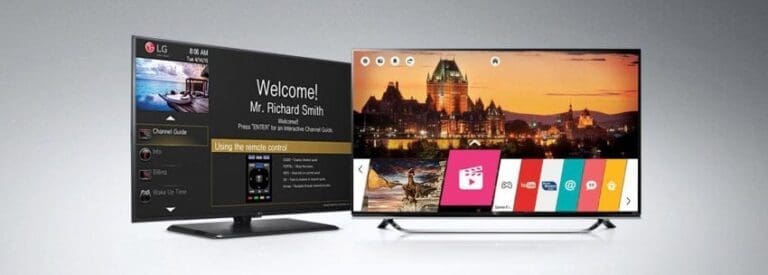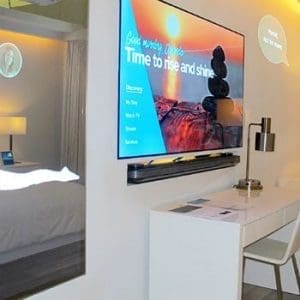Commercial TVs may look very similar to your garden variety consumer televisions, but they are designed with some very intelligent quirks that allow your hotel to look the best it can at all times. Many hoteliers become mesmerized by the price points of consumer models, but be advised that IT purchasers need to pay close attention to display lighting, hours of operation, the locations of the televisions, and more. Here are some of the useful differences that major manufacturers provide within their commercial television models. This information will help you make a more educated decision when purchasing commercial TVs for your new hotel, or when upgrading existing televisions in the near future.
 Visibility and durability are key
Visibility and durability are key
Commercial television displays are packed with features that help your business communicate better with patrons, but visibility and durability are definitely the front line of this strategy. The commercial line is built to withstand a business environment, whereas consumer models are designed solely for domestic placement. Commercial TVs also follow stricter guidelines when releasing new models, whereas consumer models are updated to continue meeting household needs.
Commercial TVs are more ruggedly designed to successfully endure a longer life-cycle within their commercial placements and operation. One of the main differences you will notice upon first glance at a commercial display, is that the frames are built with straighter, sturdier lines. This is a result of not only more durable design demands, but also the need to be more flexible for a variety of placements within hotels. Consumer televisions often have smooth curves along the chassis, making them more aesthetically pleasing for a home. Commercial displays eliminate these curves for easier placement within your property, and to facilitate side-by-side viewing for video walls, digital menu boards, etc.
Portrait mode
Speaking of video walls, commercial TVs are also fitted with more advanced cooling technology to support “Portrait mode”. “Portrait mode” is the ability to mount a commercial televisions sideways, and so hoteliers can communicate with patrons via a vertical format. Portrait-oriented displays can add new dimensions to your guest experience, and at no additional charge. Many hotels are creating portrait format video walls as an informational focal point for their guests. Drink menus, food menus, event listings, weather reports, transportation schedules, special offers, and other types of information benefit greatly from a commercial television’s portrait layout.
For purchasing and procurement agents, these next few bits of strategic design elements may forever change the way you look at consumer model price points for your hotel’s TVs. A consumer television and a commercial television differ in the greatest amount by a measurement of usage. Consumer TVs are designed to operate for the few hours a day someone is home, relaxing in front of TV shows, movies, or video games. Commercial televisions, by contrast, are specifically engineered to continuously operate between 16 and 24 hours per day, and up to 7 days per week.
In addition to being built to last the test of heavier business usage, they are also designed to prevent the issue commonly known as “image retention” or “burn in”. Commercial televisions often display the same image or set of images of approved promotional content over and over for the entirety of their life-cycle, and would most certainly experience the unsightly symptoms of “burn in” if not for their commercial grade enhancements. No business owner wants to see the silhouettes of multiple promotional images ruining their branding, let alone allow their customers to notice it as well.
Warranty
There is also the ever-so-imminent topic of warranty. Consumer televisions normally come with a manufacturer’s warranty covering parts and labour for one year. Commercial TVs normally come with 2 – 3 year warranties depending on the manufacturer and model. So, not only is your commercial TV display built to last longer under more strenuous conditions, but it is also covered longer under the manufacturer warranty. If it’s built stronger, lasts longer, and is covered further, it should be an easy decision to choose a commercial TV over a consumer model for your hotel.















